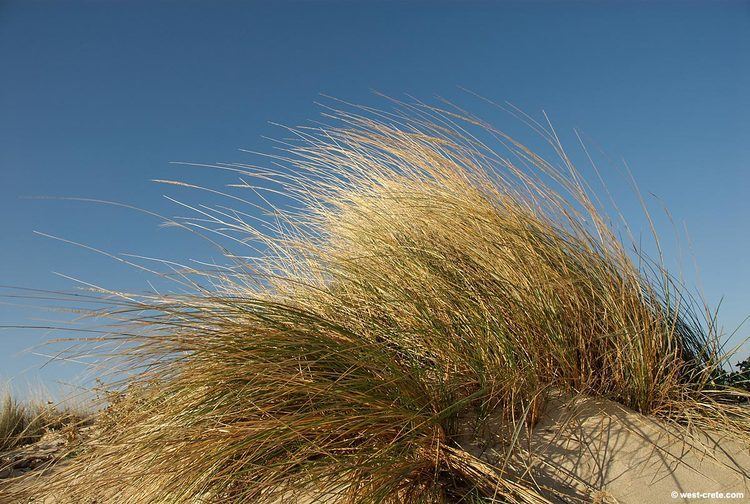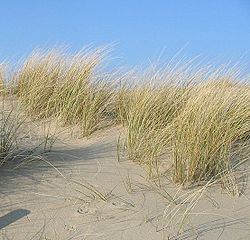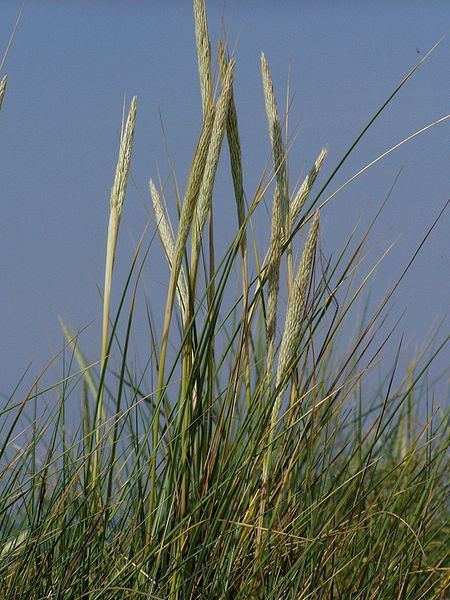Higher classification Ammophila | Scientific name Ammophila arenaria Rank Species | |
 | ||
Similar Ammophila, Grasses, Leymus arenarius, Cakile maritima, Eryngium maritimum | ||
European marram grass ammophila arenaria 2013 09 08
Ammophila arenaria is a species of grass known by the common names European marram grass and European beachgrass. It is one of two species of the genus Ammophila (marram grass). It is native to the coastlines of Europe and North Africa where it grows in the sands of beach dunes. It is a perennial grass forming stiff, hardy clumps of erect stems up to 1.2 metres (3.9 ft) in height. It grows from a network of thick rhizomes which give it a sturdy anchor in its sand substrate and allow it to spread outward. These rhizomes can grow laterally by 2 metres (7 feet) in six months. One clump can produce 100 new shoots annually.
Contents
- European marram grass ammophila arenaria 2013 09 08
- Invasiveness Pacific coast of North America
- Life cyclephenology
- Natural global range
- New Zealand range
- Habitat preferences
- Diet and foraging
- Predators parasites and diseases
- Cultural uses
- References

The rhizomes tolerate submersion in sea water and can break off and float in the currents to establish the grass at new sites. The leaves are thick and coated in a white waxy cuticle. They are up to 1 metre (3.3 ft) long and sharply pointed. The cylindrical inflorescence is up to 30 centimetres (12 in) long. It is adapted to habitat made up of shifting, accreting sand layers, as well as that composed of stabilised dunes.

Invasiveness: Pacific coast of North America

A. arenaria is also recognised as one of the most problematic noxious weeds of coastal California. This sand-adapted grass was introduced to the beaches of western North America during the mid-19th century to provide stabilization to shifting sand dunes. It grew readily and it can now be found from California to British Columbia. The grass is invasive in the local ecosystems, forming dense monotypic stands that crowd out native vegetation, reduce species diversity of native arthropods, and cover vital open stretches of sand used for nesting by the threatened western snowy plover (Charadrius nivosus). The plant's spread has changed the topography of some California beach ecosystems, especially in sand dunes. The presence of this grass was a major cause of the destruction of native dune habitat in Oregon and Washington during the 20th century.

Several methods have been employed in attempts to eradicate the grass in California, including manual pulling, burning, mechanical removal followed by salt water irrigation, and glyphosate application. Studies to find the best methods are ongoing.

Not only is it invasive in California, it is also a highly invasive weed in coastal areas of New Zealand and Western Australia, where it was introduced for the same purpose in California to stabilise dunes; outcompeting native spinifex species.
Life cycle/phenology
Ammophila arenaria is a perennial plant, which can live for a lot of years in the earth. It mainly grows in spring and leaf production exceeds lead senescence. But the condition in autumn is contrast that it nearly stop growth while its leaves become senescence. In winter, since the temperature is so cold, the growth is very slow but rather than stopping growth.
This plant is highly adaptive in sand, which can withstand burial for more than one year. Unlike the other plant which will die in sand, this plant will elongate its leaves when it buries by sand.
Its inflorescences are initiated in autumn of the second year after germination and mature in May or June, and its flowers are always produced from May to August. But this is changed to May in Europe because of the different climates. And it is always mature in September, and the seeds germinate in the next spring. Though the plant is strong in live, it has a low viability for seeds, and the seeds are in low survival ability too because of desiccation, burial and erosion. The main organ for its production is rhizomes, which is dispersed along the shore by wind and water.
Natural global range
Ammophila arenaria is Europe and South Africa native plant. It occurs in Australia, Canada, Chile, Falkland Island (Malvinas) (sub-Antarctic), New Zealand, South Africa and United States (USA)
New Zealand range
- Terrestrial. Coastal line side, usually occurs on sand dunes, sometimes often in inland site with low fertility. It occurs in the Wellington region and extends from to 55 to 32 degrees south latitude. In the Northern Hemisphere, it grows between 30 and 63 degrees north latitude. There are some invade especially occurs in Chamtham Islands, Otago Region, Doughboy Bay and Mason Bay.
Habitat preferences
Ammophila arenaria grows in low organic matters and free drainage, mostly in mobile or semi-stable sand dunes. It is highly suited for the sand condition and growing fast, avoid the senescence when the fresh sand continued. The soil range suit for the Ammophila arenaria grows from 4.5 - 9.0 and the temperature range from 10 - 40 degrees, and salt concentrations of no more than 1 - 1.5%. In inland situation, other species establish habitat when the sand movement stable and Ammophila arenaria become to displace the other native plants in coastal.
Diet and foraging
Marram grass plants on coastal sand dunes all over the world. It more like growing on the active sand area and windward side of foredune. It should be planted on well-drained soils with different kinds of mineral compositions. The best soil condition for marram grass is the soil pH range from 4.5-9.0, soil temperature from 10-40 degrees Celsius. Marram grass can be found on a high alkaline which pH around 9.1 and also found on acid lands which pH less than 4.5. Adult plants tolerate has a large range of chemical issues. Marram grass has a well ability to adapt dry sand. Leaves rolled and tight when the moisture levels are low.
Predators, parasites, and diseases
Marram grass do not record serious main disease in New Zealand, because only 3 pathogenic fungi (Claviceps purpurea, Uredo sp. and colletotrichum graminicola) are present on the island. These three fungi result in ergot, rust and leaf spot and are found both on flower-heads and leaves. However, in European countries, there are a lot of pests known to feed on marram grass. Those pests killed 30%-40% of the tillers, and also damaged other species. Those fungi, always found in soil, may decrease the vigour on the stabilized sand.
Cultural uses
Marram grass can be useful for edible uses, medical uses and other uses. People use the flowering stems and leaves for thatching, basketry and making brooms. Fiber from the stem is used for making paper, then the rhizomes are used for making rope and mats.
